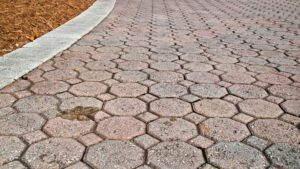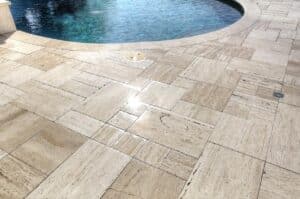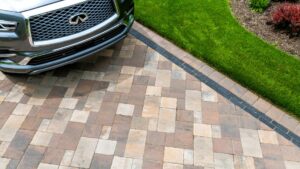Travertine coping pavers are an exquisite addition to any pool space. They are renowned for their timeless beauty, durability, and versatility. These natural stone pavers offer a range of benefits that make them a popular choice for pool coping, patio edges, and other architectural applications.
In this comprehensive article, we will delve into the world of travertine coping pavers, exploring their origin, characteristics, installation, maintenance, and design possibilities.
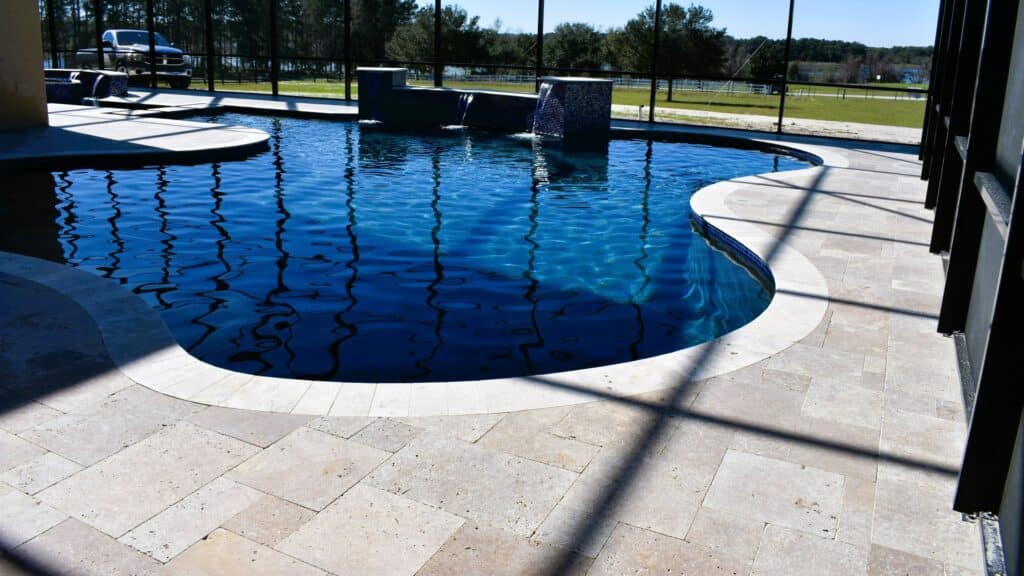
Travertine coping pavers: what is travertine?
Travertine is a sedimentary rock – which emerges as a result of minerals precipitating from geothermal springs over an extended period. This fascinating formation process lends travertine its distinct characteristics and makes it a sought-after material for various applications.
Travertine exhibits a diverse range of natural earthy tones that add a touch of elegance and warmth to any space. The color palette of travertine ranges from creamy whites, which evoke a sense of purity and tranquility, to warm beige that exudes a welcoming ambiance.
Additionally, rich browns found in travertine create a sense of earthiness and sophistication. The availability of such a broad spectrum of hues makes travertine a versatile material that can be easily incorporated into various design styles and aesthetic preferences.
Advantages of travertine coping pavers
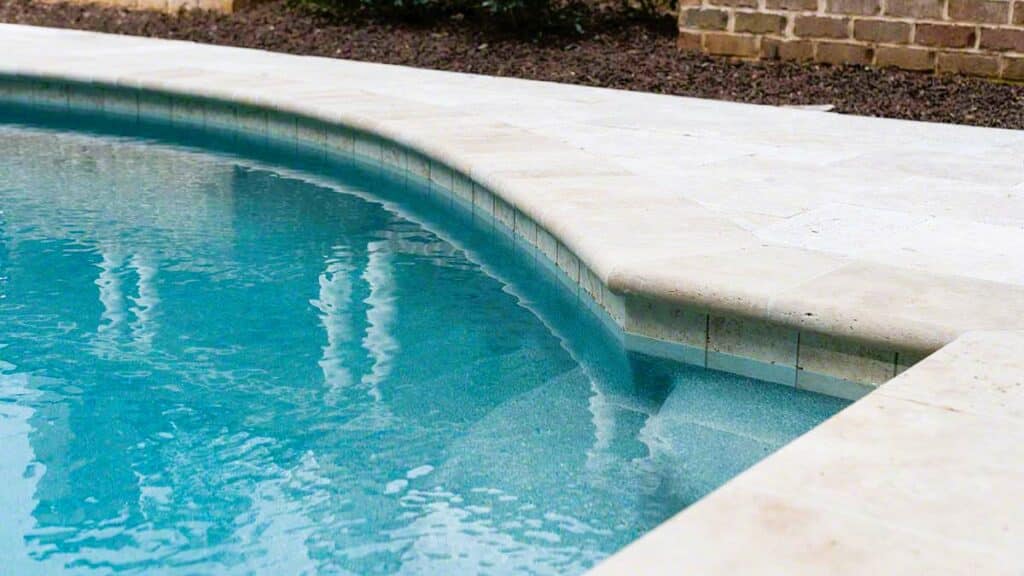
One of the remarkable features of travertine is its porous texture. The rock’s surface is dotted with countless interconnected pores and cavities, which give it a unique and captivating appearance.
This porous nature also contributes to its practicality, as it allows for efficient drainage of water and prevents the accumulation of moisture, making it an excellent choice for outdoor installations.
Two very important aspects when talking about pool settings are slip and heat resistance, two things that travertine pavers excel at.
One of the key advantages of travertine is its ability to remain cool even in scorching temperatures. This makes it a comfortable surface for bare feet, especially around pools and patios where exposure to sunlight is high.
They also offer excellent slip resistance due to their textured surface. This makes them a safe choice for pool coping, minimizing the risk of accidents caused by wet or slippery conditions.
With proper installation and maintenance, travertine coping pavers can withstand the test of time. The stone’s robust nature makes it resistant to cracking, chipping, and extreme weather conditions, ensuring longevity and value for your investment.
Installing travertine coping pavers: DIY guide
Installing travertine coping pavers requires a meticulous approach to ensure a durable and visually pleasing result.
Before starting, carefully plan the layout and design of the coping area.
Consider factors such as the pool shape, desired aesthetic, and any necessary slopes or curves. Measure and mark the perimeter of the area, taking into account the required dimensions and allowances for expansion joints.
Properly preparing the foundation is crucial for long-term stability. Excavate the area to the appropriate depth, which is 6 inches plus the thickness of the coping pavers. Ensure adequate drainage by sloping the excavated area away from the pool at an increment of 1 inch every 4 feet.
Establish a solid foundation by laying a compacted gravel base. Start by adding 1 inch of gravel, and then compact it with a hand tamper. Keep adding and compacting in 1-inch increments until you have a 5-inch compacted gravel base.
This base layer provides stability and prevents shifting or settling of the coping pavers. On top of that base layer, you will create a bedding layer using a sand and cement mixture. Level the bedding layer carefully using screed boards and a spirit level to ensure an even surface for the pavers.
Carefully set the coping pavers into place, starting from one end and working your way toward the other. Take care to align the pavers accurately and maintain a consistent level throughout the installation. Use a rubber mallet to gently tap the pavers into position, ensuring they are firmly seated.
Once the coping pavers are set, fill the joints between them with polymeric sand. This step prevents weed growth, minimizes water penetration, and enhances the stability of the installation. Follow the manufacturer’s instructions for proper application and compaction of the jointing material.
To protect the travertine coping from staining and weathering, apply a quality stone sealer. Choose a sealer specifically designed for travertine, and carefully follow the recommended application methods and drying times.
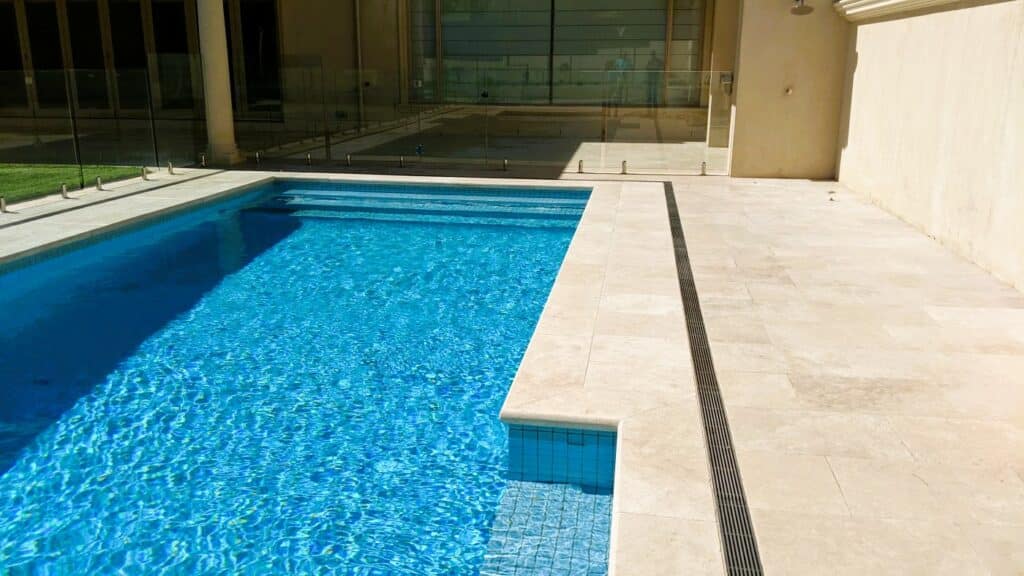
Maintenance tips
To ensure the longevity and beauty of your travertine coping pavers, it’s essential to follow proper maintenance practices.
Sweeping the surface of your travertine coping pavers on a regular basis is crucial to prevent the buildup of dirt, leaves, and other debris. Use a broom with soft bristles to avoid scratching the stone.
For deeper cleaning, use a pH-neutral stone cleaner specifically formulated for travertine. Dilute the cleaner as instructed and gently scrub the pavers with a soft brush or mop. Avoid using harsh chemicals or acidic cleaners, as they can damage the stone and alter its natural appearance.
Accidental spills can happen, but it’s important to clean them up promptly to prevent staining. Wipe away any spills or stains immediately using a soft cloth or paper towel.
Avoid dragging heavy objects or furniture directly on the travertine surface, as they can cause scratches or gouges. Place coasters or mats under outdoor furniture to provide an additional layer of protection and prevent potential damage.
To maintain the resistance of your travertine coping pavers to stains and moisture, it’s important to periodically reseal them. The frequency of sealing depends on the level of use and the climate in your area. Generally, it is recommended to reseal travertine every 1 to 3 years.
If you live in a colder climate where freeze-thaw cycles are common, it’s important to take extra precautions to protect your travertine coping pavers during the winter months.
Avoid using de-icing chemicals, as they can damage the stone. Instead, use sand or non-salt-based deicers to provide traction on icy surfaces. Applying a winter-specific sealer before the onset of cold weather can help provide an additional layer of protection.
Start your project today!
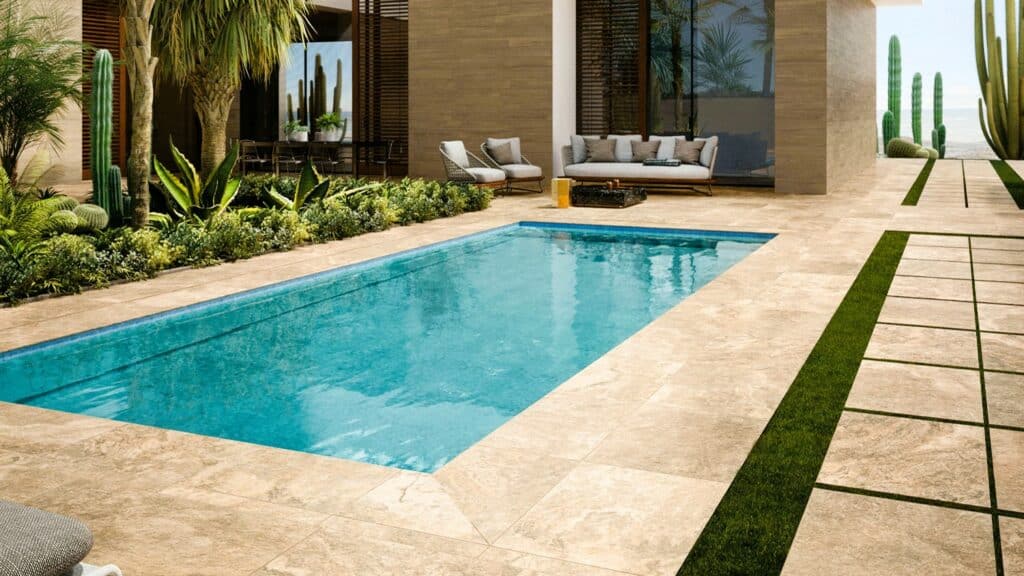
Travertine coping pavers are a magnificent choice for those seeking durability, elegance, and versatility in their outdoor spaces.
Of course, they shine as pool surrounding, but can also be used on patio edges. These natural stone pavers offer a timeless charm that enhances the overall aesthetic appeal. With proper installation and maintenance, travertine coping pavers can withstand the test of time, making them a valuable investment.
Whether you prefer a classic or contemporary design, the design possibilities are vast, allowing you to create stunning outdoor areas that are both functional and visually striking. Explore the beauty and versatility of travertine coping pavers, and elevate your outdoor living experience to new heights.
And, of course, a good installation is extremely important. So if you’re not absolutely sure you can handle that by yourself, your best course of action is to hire professional hardscape contractors to help you.
We here at S&S Pavers, for the last 13 years, have worked tirelessly throughout Sarasota County, in FL, helping homeowners with their poolside installations, as well as many other hardscape elements.
We know how important it is to be sure of what you’re doing every step of the way, that’s why we always recommend working with professionals you can trust around your area.
And if you happen to be around our area of activity, you can always get in contact with us so we can help you start your project today!

